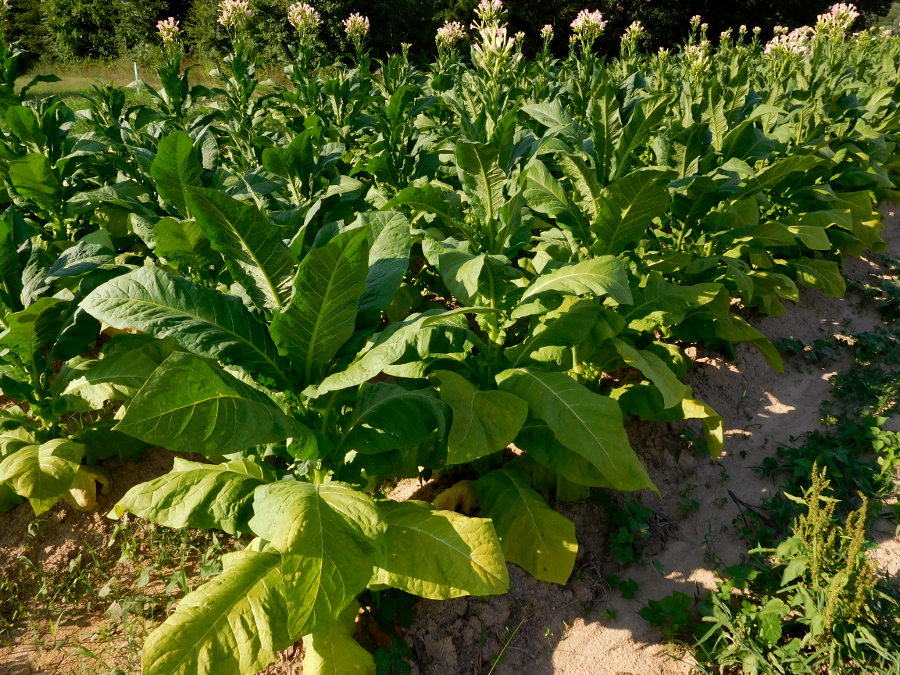
tobacco (Nicotiana rustica) is a flowering plant brought from Ecuador/Peru to Virginia first by Native Americans, long before John Rolfe obtained seeds from a different species (Nicotiana tabacum) that was sweeter when smoked

tobacco (Nicotiana rustica) is a flowering plant brought from Ecuador/Peru to Virginia first by Native Americans, long before John Rolfe obtained seeds from a different species (Nicotiana tabacum) that was sweeter when smoked
Farming patterns based on physical geography led to the development of different social patterns in New England vs. Virginia.
The New England colonies had thin rocky soils, remnants of the what the ice sheet left after scraping across the land 20,000 years ago. Cape Cod and Long Island were created in part from the dirt that the ice sheet shoved eastward.
In New England, intensive management was required to produce a profitable crop. Stones had to be moved and fertilizer (animal manure) had to be applied to grow wheat and other crops during the shorter summers in Massachusetts and New York. Farming was intensive, with a great deal of human effort invested in each small, hilly field to improve the productivity of the New England soil over the years.
Farms produced food (wheat, meat, milk, etc.) and fiber (such as wool from sheep, or linen from flax). The New England farm products were sold locally, rather than shipped back to England. Major exports from New England included fish and lumber, which was manufactured into new ships.
In contrast, in the Coastal Plain and Piedmont of Virginia there was plenty of fertile and flat land. Virginia also had a longer growing season between the last frost in the Spring and the first frost of the Fall.
There was a large supply of fertile land in Tidewater and on the Piedmont, and Southern colonists practiced "extensive" rather than "intensive" agriculture. There were many more acres under cultivation on Virginia farms compared to New England farms. Virginia farms were larger, but the yields per acre were lower.
Virginia colonists quickly centered nearly all of their investment on growing one staple crop, tobacco. They literally "bet the farm" that the crop would be successful and the prices in England would be high enough to make a profit.
a few tobacco plants were allowed to produce seeds, but laborers cut the tops off most plants to force more growth into the leaves
Soil eroded from Virginia fields during summer thunderstorms, and tobacco exhausted the minerals and nutrients in the soil. Abandoning exhausted land was no problem; in the largest colony in the New World, there was plenty of virgin wilderness to convert to new farmland. For the first 200 years of European settlement, Virginians could afford to abandon a farm field after several years, just as the Native Americans had done.
Because Virginians created a legalized form of slavery, there was plenty of low-cost labor to work the low-cost land. The prices paid for tobacco fluctuated, but so long as Virginians kept the costs of farming low the "plantation" economic model was successful.
The "First Families of Virginia" (FFV's), such as the Carters, Randolphs, and Lees, gained great wealth. They built great mansion houses such as Carter Hall, Stratford Hall, Mount Vernon, Gunston Hall, and Monticello. The famous colonial-era mansion houses are almost all east of the Blue Ridge, because the settlers west of the Blue Ridge operated without many slaves until the railroads arrived.
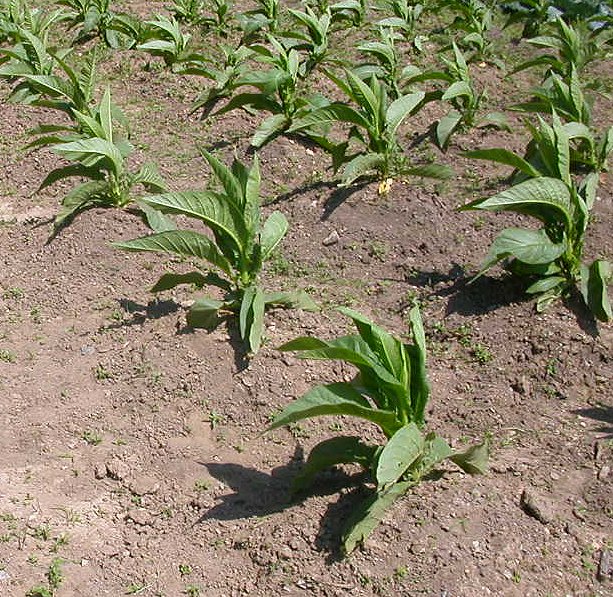
tobacco at Mount Vernon (George Washington's plantation)
In the colonial era, the Spanish in Mexico and Florida recruited Native Americans to live near missions and grow farm products for the friars. Virginians tried but failed to enslave enough Native Americans to provide cheap labor, so the plantation owners found two other sources of settlers to grow their staple crop of tobacco for export.
The initial Virginia labor force consisted of English immigrants, transported across the Atlantic Ocean to Virginia from London and other English cities. Many of the rural poor in England chose voluntarily to migrate to Virginia. It was a major gamble to move to the colony - but at least they had some opportunity to buy land in Virginia, while the chance of accumulating enough savings in England was close to zero.
Getting across the Atlantic Ocean was not cheap in the 1600's. To pay for the trip, many Englishmen and Englishwomen agreed to work for a master in the colony. The immigrants signed an "indenture" to document that commitment in exchange for the trip. The master of the indentured servant was obliged to provide food, shelter, and clothing during the indenture, which was often a seven year contract.
The plantation owners paid ship captains for transporting new laborers. To help finance immigration, the colonial government granted 50 acres (a "headright") to the plantation owner for every person imported to Virginia.
The individual in England provided labor over 7 years, the colony provided land to the plantation owner, the ship captain brought a body to the plantation owner, and the plantation owner paid the ship captain in tobacco that had been produced by indentured servants who had been imported previously.
In the initial years of the colony, the Virginia Company generated propaganda to recruit immigrants, but an English family who sold everything to pay for a trip to Virginia in the first dozen years of the colony would have found it hard to do more than scratch out a living for themselves in the colony.
The Virginia Company even went so far to establish a House of Burgesses in 1619 to give the immigrants political rights. Still, immigration was low, the death rate of those who did immigrate was high, and the European population of the colony grew so slowly that the London Company could not make a profit from trade.
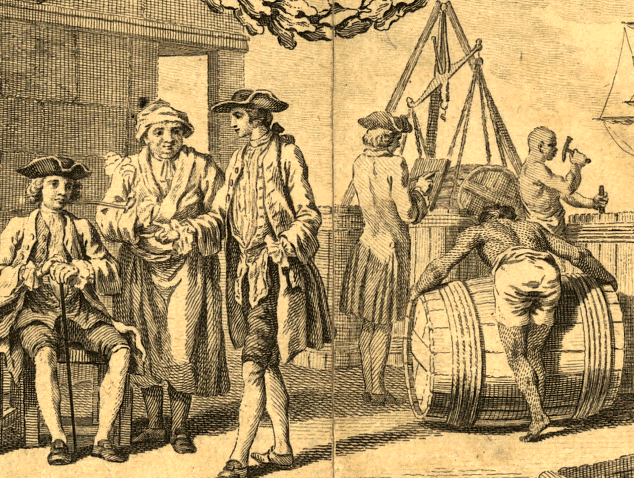
are just the rich white tobacco planters portrayed in this image of inspecting and shipping tobacco in "hogshead" barrels?
Source: Library of Congress, Fry-Jefferson map cartouche
Tobacco production was limited because the few colonists could produce only so much tobacco. One person could work 1-5 acres of land in a year - so a 50-acre headright was a generous grant for importing each worker. The London Company had plenty of land under its control in Virginia, but the workers were in England.
If the private company could have borrowed vast sums to pay for transporting more immigrants to Virginia, perhaps the private investors could have finally reaped a profit from their company. However, in 1625 the king of England revoked the London Company charter, the private (and unprofitable) colony became a crown colony, and the investors who had ventured their capital took a financial loss.
A few people came to the Virginia colony in the early 1600's with personal wealth from England. Those with some initial capital could pay ship captains for transporting workers and acquire headrights. Farming more land with more indentured servants led to greater profits from exporting tobacco back to England. Those families who ended up in the gentry often "started small" and worked their way to greater wealth. Only a few were wealthy enough to "start big."
The imported indentured servants would grow tobacco for a plantation owner to import more people, and tobacco sales would trigger grants for more land (50 acres per imported person) to expand the plantation. Colonists with access to capital in the 1600's, perhaps drawing on family wealth in England, were able to accumulate both land and labor. The rich became richer, and established a new "gentry" class in Virginia in the early 1700's.
During the English Civil War in the mid-1600's, some "Cavaliers" who supported King Charles I and King Charles II fled England, to escape the Puritan repression. Some of those new immigrants had wealth, education, and business connections. They were able to finance importation of laborers, acquire more land by headrights, grow more tobacco, and restart the cycle by financing importation of more laborers. An oligarchy of a few wealthy "First Families of Virginia" evolved in the late 1600's, and those families displayed their wealth by constructing brick mansions in the 1700's.
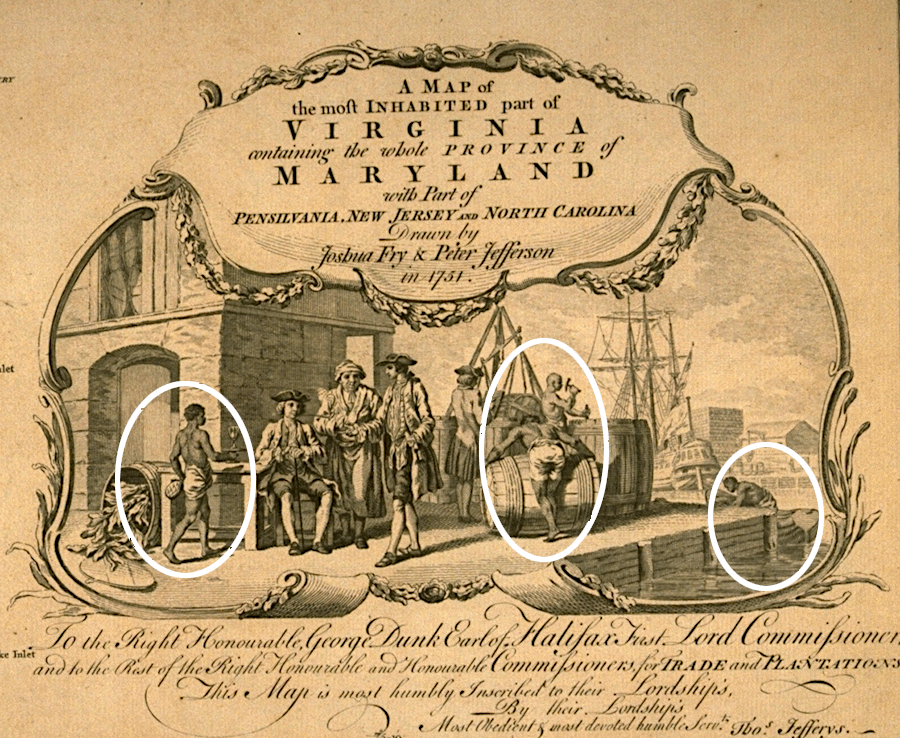
the cartouche on the Fry-Jefferson map documented how enslaved workers shipped hogsheads filled with tobacco, and catered to the plantation owners and ship captains
Source: Slavery Images: A Visual Record of the African Slave Trade and Slave Life in the Early African Diaspora, Shipping Tobacco, Virginia, ca. 1755
White laborers usually signed a contract or "indenture" for a few years of work, in exchange for transportation costs to Virginia. Indentured servitude was not slavery. An indenture was a contract, and the colonial court system helped to protect servants from unscrupulous plantation owners who did not hold up their end of the bargain.
At the end of the 7 years, the plantation owner was obliged to give a few basic supplies to the laborers who had completed their term of indenture. In many cases the newly-freed indentured servants would end up on the edge of European settlement (the "frontier") where land was cheap and carve a small farm out of the wilderness. New small farmers started paying taxes, attending the local Anglican church, and extending English social patterns to the Blue Ridge.
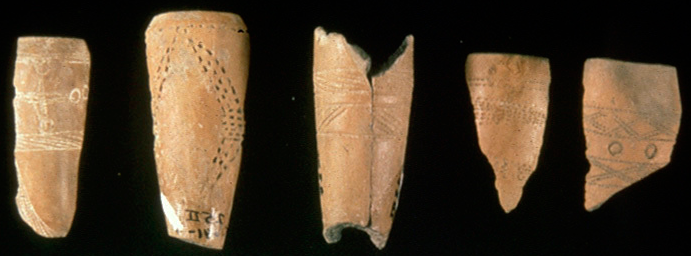
Native Americans, colonists, and enslaved workers decorated pipes they made in the Chesapeake Bay region with distinctive pin-like indentations
Source: Virginia Humanities, Virginia Indian Archive, Five Chesapeake Pipe Bowl Fragments
Why didn't the London Company find laborers to grow tobacco from places other than England?
Unlike the Spanish colonies in the Caribbean islands, Native Americans were not enslaved in Virginia to provide the initial labor force. Powhatan, the primary chief of the tribes in eastern Virginia, and his successors were able to maintain their independence for 15 years after Jamestown was established. The tribes controlled by Powhatan did not have the same technology as the English who sailed up "Powhatan's River" (James River) in 1607, but the Native Americans had sufficient weapons and courage to preserve their way of life in parallel with the English for several decades.
Opechancanough convinced the tribes that peaceful coexistence was no longer acceptable and led a major uprising in 1622. After it failed, the English excluded the Algonquians from their plantations. Eventually the English even built a wooden palisade (a wall...) from the James River to the York River, to define a region where Native Americans were not permitted.
Powhatan's approach was not successful, but his tribes were not enslaved and forced to raise tobacco on English plantations.
A massive decline in Native American population after exposure to European diseases also reduced the potential for using Virginia's original inhabitants as a labor force for growing tobacco. The Spanish had experienced the same on the Caribbean islands, stimulating the original imports of slaves from Africa.
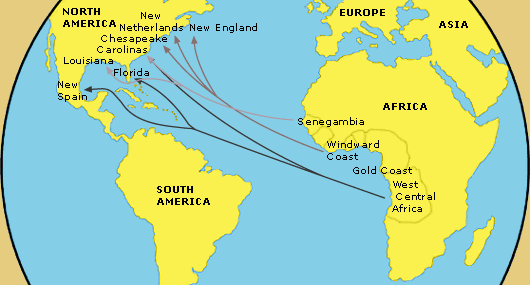
slave trade from Africa to North America (omitting those shipped to Brazil/Caribbean)
Source: National Park Service, The Transatlantic Slave Trade)
Why didn't the London Company import slaves from Africa to raise tobacco from the start?
Virginia was not settled initially to be a farming colony; slavery was not part of the Virginia Company's plan for making a profit.
The first blacks from Africa were imported into Virginia in 1619, a dozen years after the English settled Jamestown. Slavery based on color gradually evolved in the Virginia colony over the next 50 years. During that time relatively few Africans were imported to Virginia, compared to the high percentage of indentured servants brought over to work on the tobacco plantations. Portugal controlled the slave trade and ship captains sailed to Spanish colonies, where the market was already well-established. Many of the slaves brought to Virginia had been carried involuntarily to Caribbean islands first.
After the London Company lost its charter, the pattern of indentured servant immigration expanded and Virginia became more profitable. More immigrants arrived after the English responded forcefully to the 1644 uprising and destroyed most Native American towns near the settled area, increasing the sense of personal security in the colony at the same time the Civil War in England reduced personal security at home.
By 1700, after nearly a century of European immigration to the New World, the supply of willing white immigrants was inadequate to meet demand - witness the problems Governor Spotswood faced trying to get iron workers to his lands at Germanna.
Lifetime slavery based on race was a new concept, but discrimination was not a new concept to the colonists. The Spanish, the French, and the English were perfectly willing to kill each other based on religion or nationality, and Bacon's Rebellion showed the English were willing to kill "Indians" based on whatever reason seemed convenient at the moment.
It took about 50 years after the first slaves arrived at what is now the City of Hampton to develop a series of laws defining perpetual slavery based on one's color, and thus to ensure a low-cost labor force in perpetuity. By 1670, the General Assembly had passed enough laws to defined the permanent subordinate role of slaves and their children.
The percentage of imported indentured servants used to grow tobacco declined, and around 1700 Virginia landowners began to purchase large numbers of imported slaves. To the Virginians of the 1700's, slavery was desirable and a new social structure based on race was justified by the economic importance of having a low-cost labor force to grow tobacco.
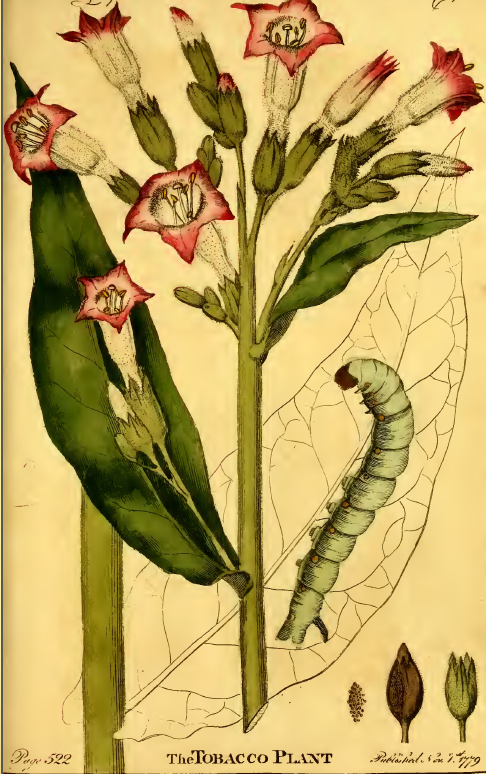
before modern pesticides, laborers had to pick worms off tobacco plants
Source: Jonathan Carver, Travels through the interior parts of North America, in the years 1766, 1767, and 1768 (p.20)
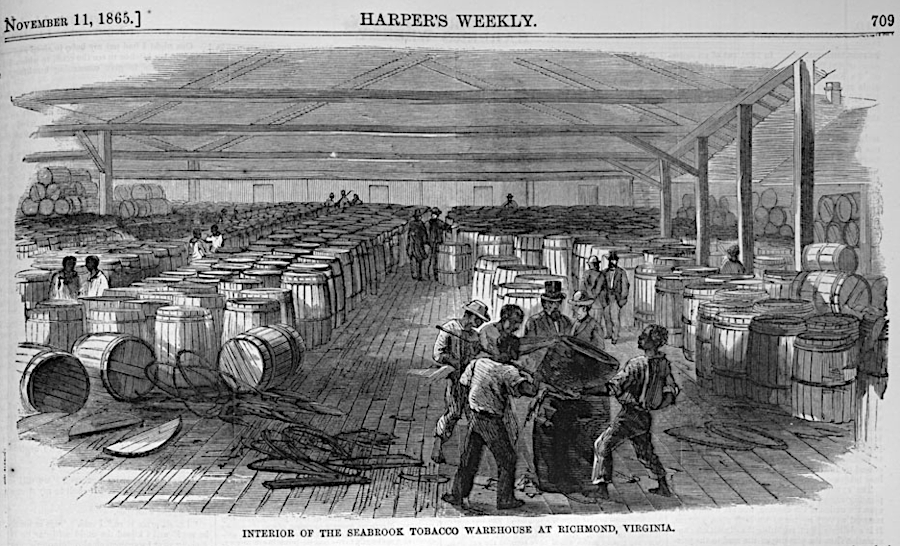
enslaved workers packed tobacco into hogsheads, as well as working in the fields
Source: Slavery Images: A Visual Record of the African Slave Trade and Slave Life in the Early African Diaspora, Interior of the Seabrook Tobacco Warehouse at Richmond, Virginia
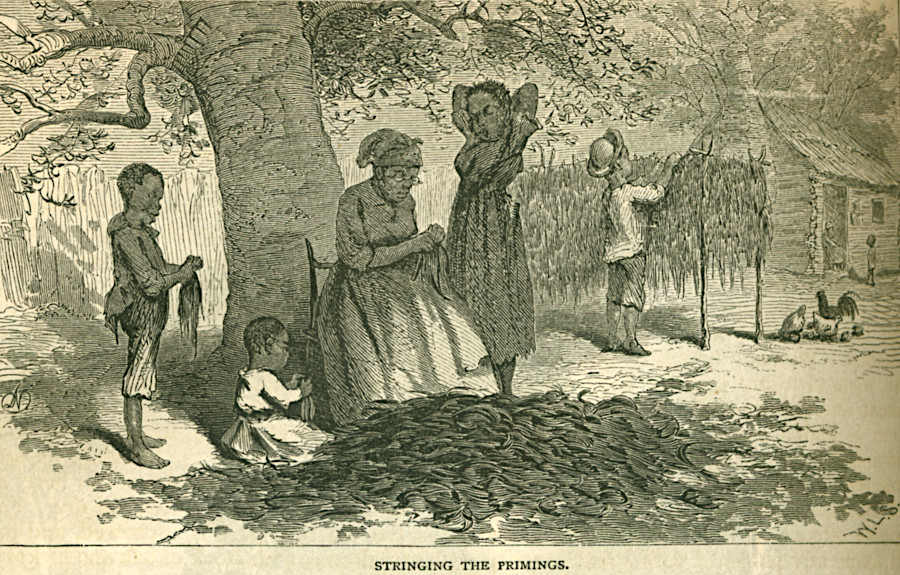
the lowest leaves of the tobacco plant (primings) were stripped off and dried
Source: Slavery Images: A Visual Record of the African Slave Trade and Slave Life in the Early African Diaspora, Tobacco Production, Richmond, Virginia, 1870s
In New England, there was far less demand for a large pool of low-skill agricultural workers. New Englanders had slaves, but far less of an economic dependence upon the "peculiar institution" of slavery. The cultural attitudes towards slavery developed differently in New England as the economic systems developed differently. The financial impact of abolition north of the Mason-Dixon line were far lower. Support in northern states for the American Civil War would have been dramatically different if northern farming also had relied upon slave labor.
By the time of the American Revolution, 40% of the population of Virginia was composed of black slaves. That high percentage was one reason the white colonists reacted so strongly to Lord Dunmore's 1775 emancipation proclamation, promising freedom to slaves who would rise up against their rebellious colonial masters.
For almost 150 years from 1700 to the end of the American Civil War, the primary laborers raising tobacco in Virginia were black men and women. They were forced to work without ever having an opportunity to get a fresh start. After seven years, indentured servants could walk to the frontier to start a new farm, but slaves could only anticipate a lifetime of working in the fields.
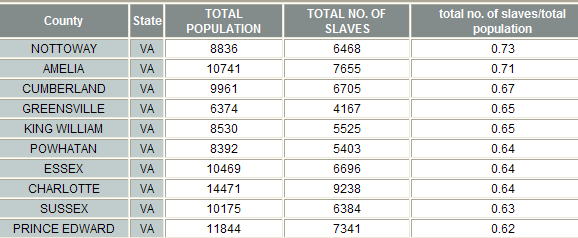
some of the 1860 population statistics
Source: Historical Census Browser
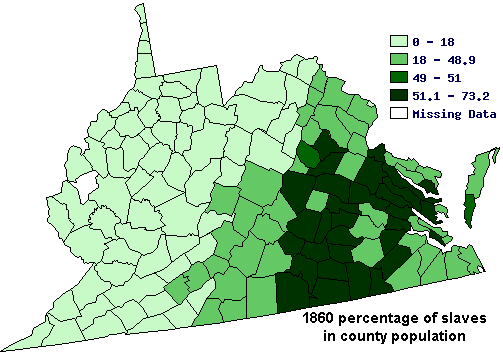
percentage of slaves in total population of counties in 1860
(note that Virginia in 1860 still included the counties of what is now West Virginia)
Source: Historical Census Browser
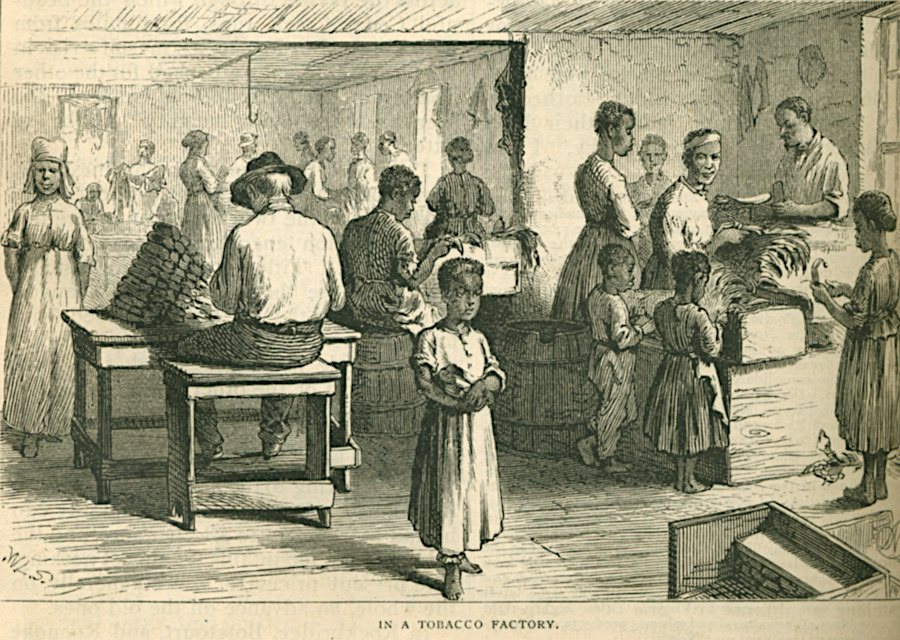
child labor was a common experience for people of color after the Civil War
Source: Slavery Images: A Visual Record of the African Slave Trade and Slave Life in the Early African Diaspora, Tobacco Factory, Virginia. 1870s
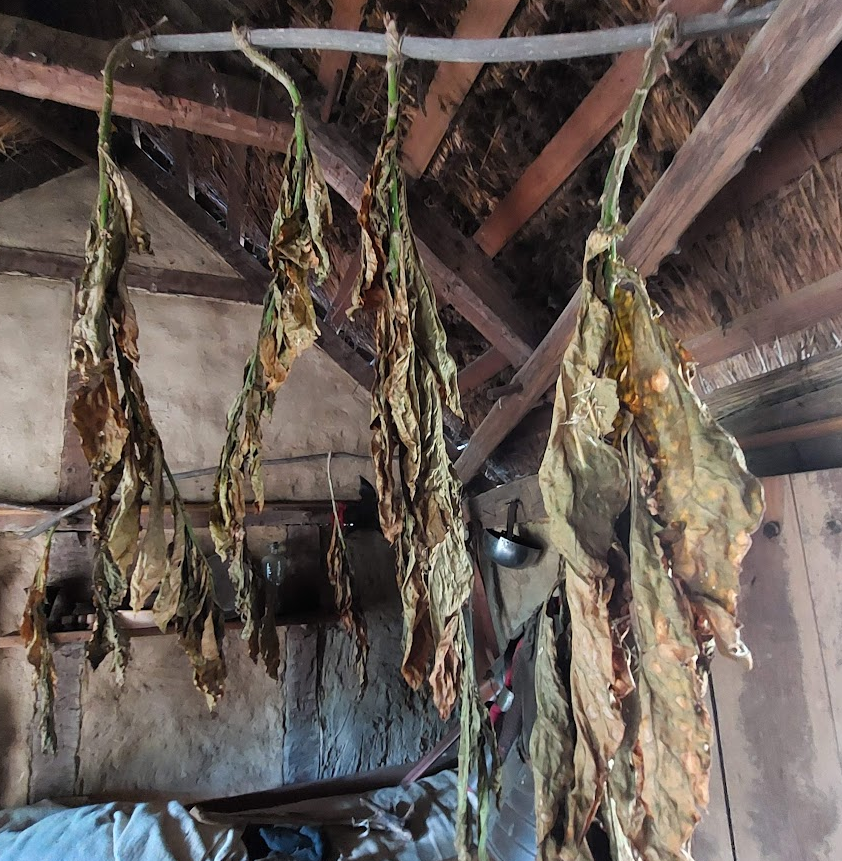
tobacco drying at Henricus Historical Park, near where John Rolfe planted the first crop in 1612